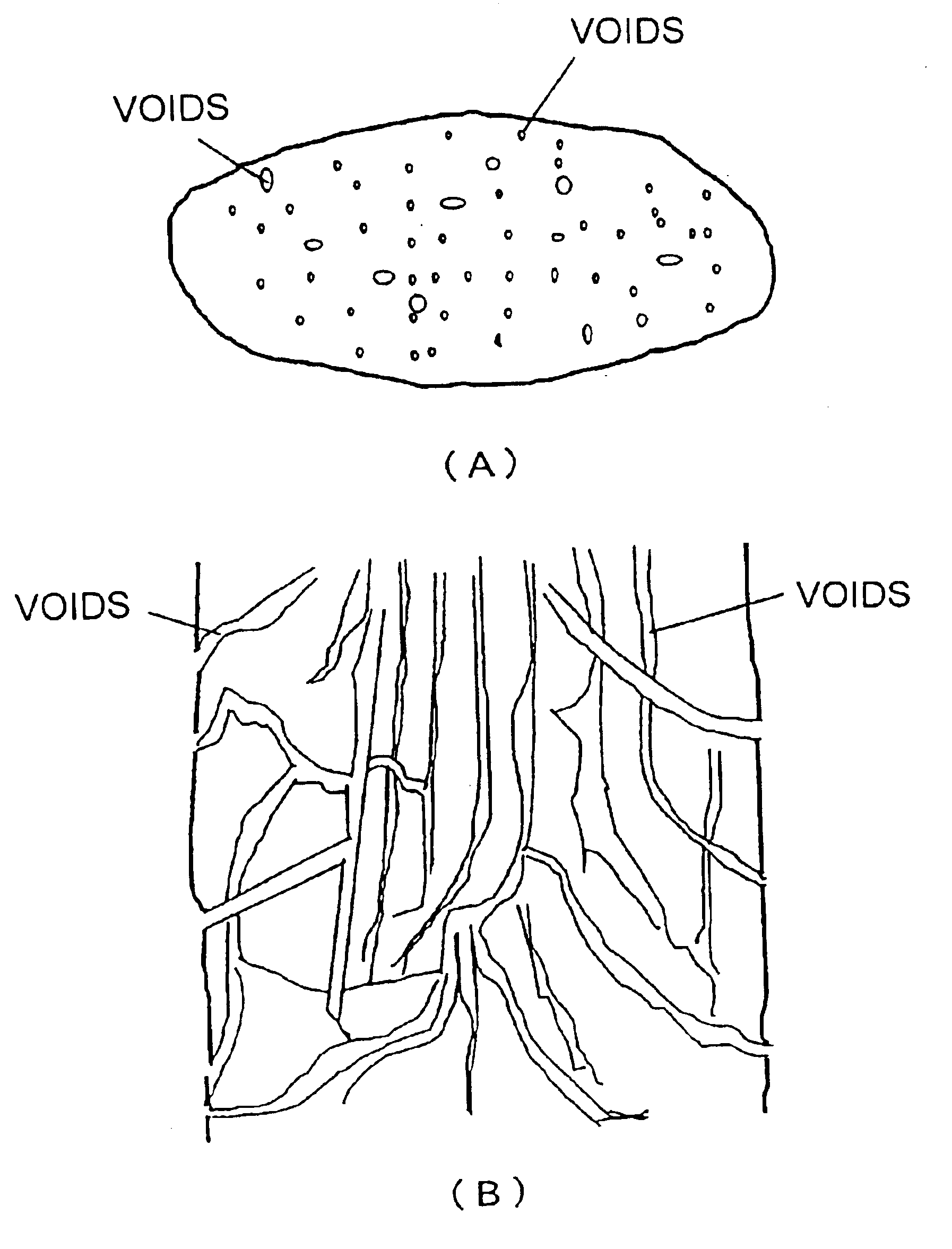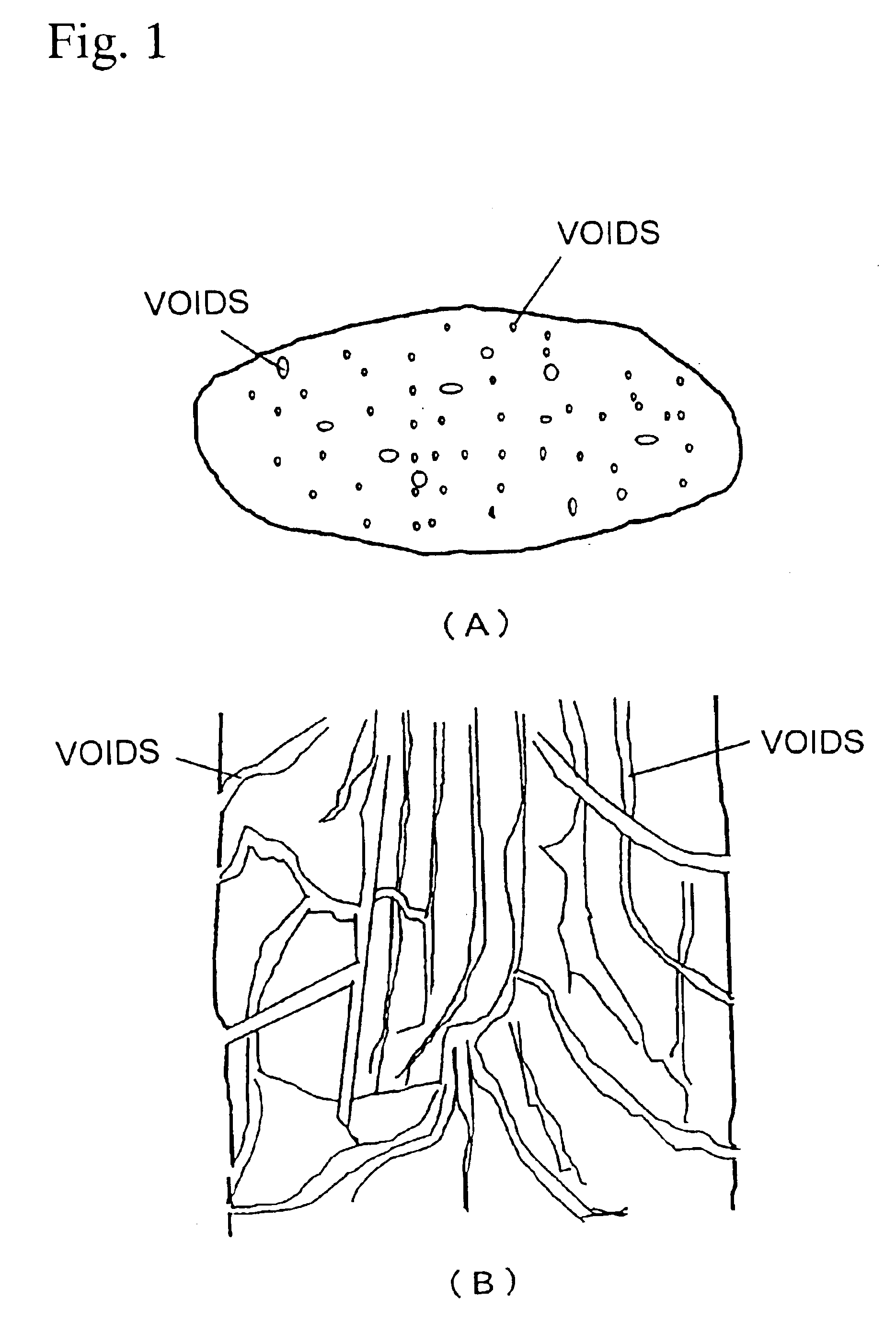However, although fibers obtained by these techniques have a fur-like external appearance at first glance, the impression that the individual fibers are covered by other surrounding fibers cannot be eliminated in cases where individual fibers are formed into a standing-hair fabric.
However, most of these effects relate to the print coloring characteristics in the pile fabric, and are not effects in which a feeling of the presence of individual fibers is visually emphasized in cases where the fabric is formed into a standing-hair fabric.
However, since this technique uses a low-boiling-point
solvent as a bubbling agent, the technique suffers from a problem in terms of manufacture: namely, it is difficult to recover the low-boiling-point
solvent used to form voids in the
fiber cross section.
Furthermore, an acrylic fiber which has a rubber-form
polymer such as a
polyvinyl acetate in an acrylic
copolymer is introduced in Japanese
Patent Application Laid-Open No.S60-110913; however, this fiber aims at preventing fiber splitting, and does not aim at endowing a fabric with an external appearance that is superior in design quality, in which a feeling of the presence of individual fibers (of the type described above) is emphasized.
Furthermore, this fiber does not have a porous structure.
Thus, in the past, there has been no technique of obtaining an external appearance in which the individual fibers are emphasized by porosification following spinning.
The reason for this is that in cases where the degree of
saponification is 50% or greater, the
solubility of PVAc in
acetone drops, so that the filterability of the spinning
stock solution drops, thus having a deleterious effect on the spinnability.
If the amount added is less than 0.3 parts by weight, the porosifying effect of the
hydrothermal treatment and / or saturated steam treatment performed following spinning is insufficient, so that porosified fibers with the desired external appearance cannot be obtained.
Specifically, an increase in the brightness, which is one of the three elements of the color that appears when the fibers are
colored to a desired
hue, cannot be obtained, so that an external appearance in which a feeling of the presence of the individual fibers is emphasized cannot be achieved.
On the other hand, if the amount of PVAc that is added exceeds 20 parts by weight, the state of phase separation between the acrylic type
copolymer and the PVAc is increased, so that the spinning stability and coagulation in the fiber forming process deteriorate, thus making
continuous production difficult.
Accordingly, such a large amount is undesirable.
Furthermore, there is an accompanying drop in the synergistic effect caused by the addition of PVAc, so that the desired external appearance cannot be obtained.
On the other hand, if the amount added exceeds 15 parts by weight, the spinning stability and drawability in the fiber forming process deteriorate, so that there is a drop in the continuous productivity or productivity per unit time.
Accordingly, such a large amount is undesirable.
In cases where this concentration is less than 20 wt %, the amount of
solvent extraction agent that is discharged from the
nozzle is increased, so that it becomes difficult to obtain a uniform cross section.
On the other hand, if the concentration exceeds 35 wt %, the
viscosity increases so that the spinning
stock solution tends to gel, and so that monofilament breakage during spinning becomes common.
If the denier is less than 2 dtex, the fibers become too slender so that a feeling of the presence of individual short fibers cannot be obtained when the fibers are formed into a pile fabric.
On the other hand, if the denier exceeds 50 dtex, the fibers become too thick, so that the resulting pile fabric tends to have a hard hand; accordingly, such a large denier is undesirable.
In cases where the maximum width exceeds this limit, the impression of a fiber-form film which imparts a disharmonious
sensation in which planarity is emphasized to a far greater extent than the linear images of the individual fibers becomes strong, which is undesirable.
On the other hand, if the flattening rate exceeds 25, a transparent image is emphasized when the fibers are viewed from a direction perpendicular to the major-axis direction, and the fiber cross section tends to split: accordingly, such a flattening rate is undesirable.
The reason that the fibers are porosified by this
hydrothermal treatment and / or saturated steam treatment is apparently that the dense structure formed by the drawing,
drying, heat treatment or steam relaxation treatment in the fiber manufacturing process is converted into a stable structure as a result of the plasticization of the acrylic type copolymer caused by the effects of excess
moisture such as
wet steam, hot water or the like in the
hydrothermal treatment of saturated steam treatment, with voids being generated at the boundary surfaces with the PVAc and
cellulose resin, which have poor compatibility with the acrylic type copolymer.
In cases where the treatment temperature is lower than 90.degree. C., a sufficient drop in the
specific gravity of the fiber is not observed regardless of the
treatment time, so that the porosification of the fiber is insufficient.
The reasons for this are as follows: specifically, in cases where the
treatment time is less than 30 minutes, a sufficient drop in the
specific gravity of the fiber does not occur, so that the desired porosified fiber cannot be obtained.
On the other hand, in cases where the
treatment time exceeds 120 minutes, yellowing of the fibers occurs.
The reasons for this are as follows: specifically, in cases where the treatment temperature is lower than 90.degree. C., no drop in the
specific gravity of the fiber is observed regardless of the treatment time, so that the porosification of the fiber is insufficient, as in the case of the hydrothermal treatment.
On the other hand, in cases where the treatment temperature exceeds 130.degree. C., the problem of yellowing of the fibers occurs.
The reasons for this are as follows: specifically, in cases where the treatment time is less than 5 minutes, a sufficient drop in the specific gravity of the fiber does not occur, so that the desired porosified fiber cannot be obtained.
On the other hand, in cases where the treatment time exceeds 90 minutes, yellowing of the fibers occurs.
On the other hand, in cases where the rate of the drop in the specific gravity (da) of the porous acrylic fiber with respect to the true specific gravity (Db) based on the acrylic type copolymer exceeds 20%, or in cases where the rate of the drop in the specific gravity before and after porosification exceeds 15%, there is a deleterious effect on the mechanical properties of the fibers.
In cases where the proportion of the porous acrylic fiber in the pile part is less than 3 wt %, the
color difference from other fibers is insufficient, so that superior external appearance characteristics in which a feeling of the presence of individual fibers is emphasized cannot be obtained.
Furthermore, in cases where the proportion of porous acrylic fibers used as the fibers that form this long pile part is less than 5 wt % of the overall pile part, and large numbers of other fibers are used as guard hairs, the porous acrylic fibers are covered by these other fibers, so that a sufficient effect in terms of external appearance characteristics cannot be obtained.
On the other hand, in cases where this proportion exceeds 60 wt %, the proportion of porous acrylic fibers in the pile fabric becomes excessively large, so that guard hairs predominate; as a result, the step effect tends to be insufficiently expressed.
Furthermore, in cases where the pile length of the long pile part is less than 12 mm, the abovementioned step effect cannot be sufficiently observed even if there is a significant step difference in the pile part.
As a result, a conspicuous effect is not obtained.
Conversely, if the pile length of the long pile part exceeds 70 mm, the abovementioned acrylic fibers in the pile fabric lack a feeling of body, so that the fabric is inadequate as a standing-hair product.
However, if large amounts of additives other than the acrylic type copolymer are present, a slight error will be generated; accordingly, it is desirable to measure this value using only the acrylic type copolymer resin.
X: Individual fibers can be distinguished by carefully directed
visual observation, so that a feeling of the presence of such fibers can be recognized to a limited extent: in an overall observation, however, it is difficult to distinguish the individual fibers, so that a feeling of the presence of such fibers cannot be recognized.
 Login to View More
Login to View More 


